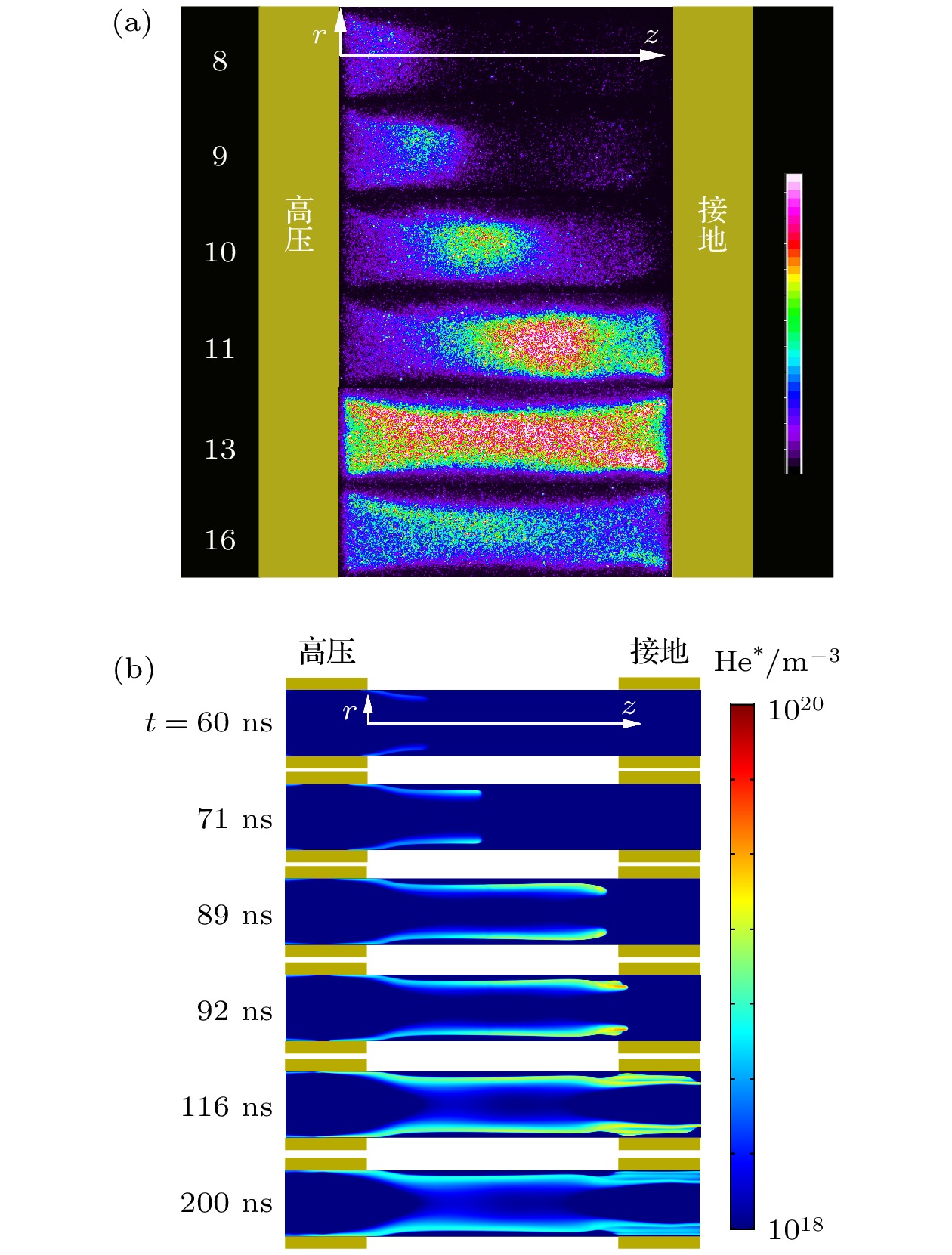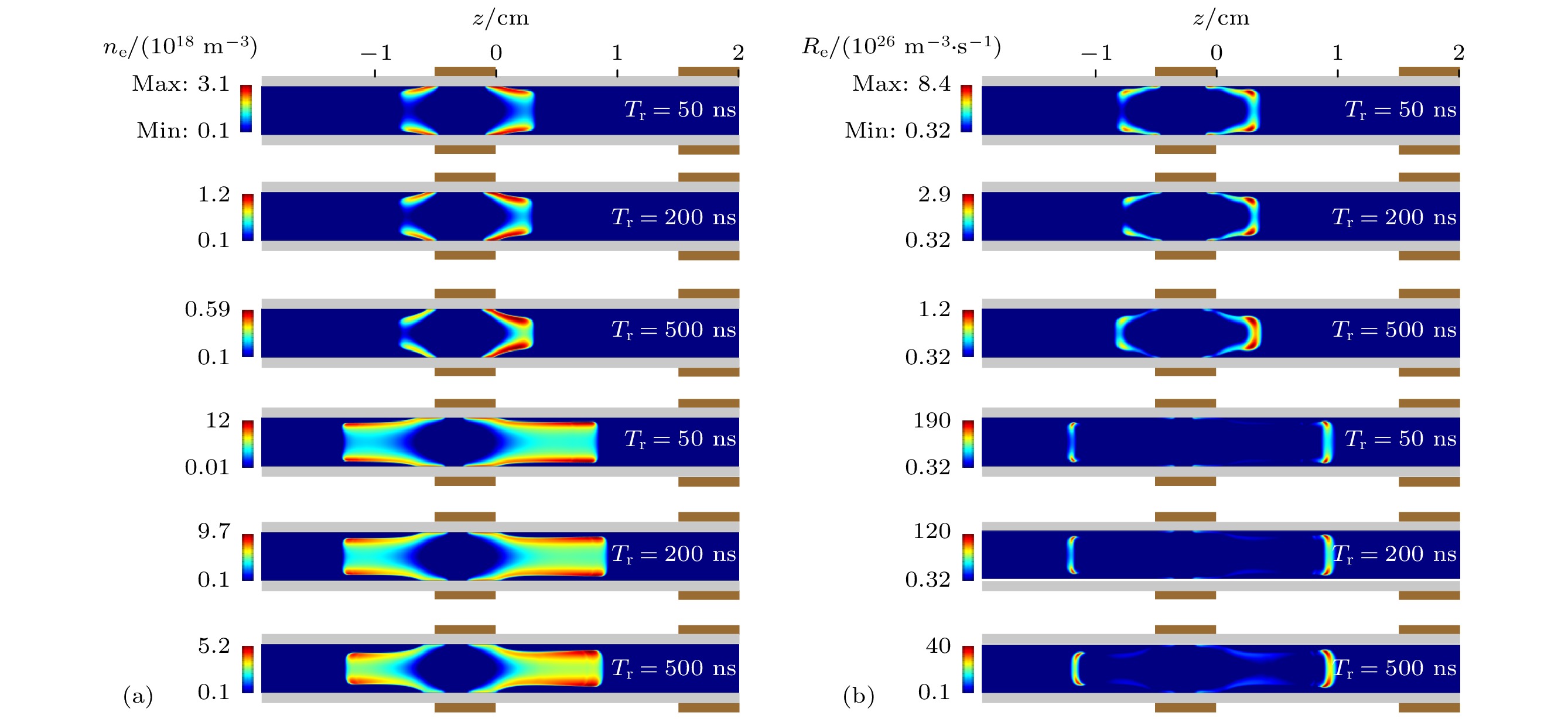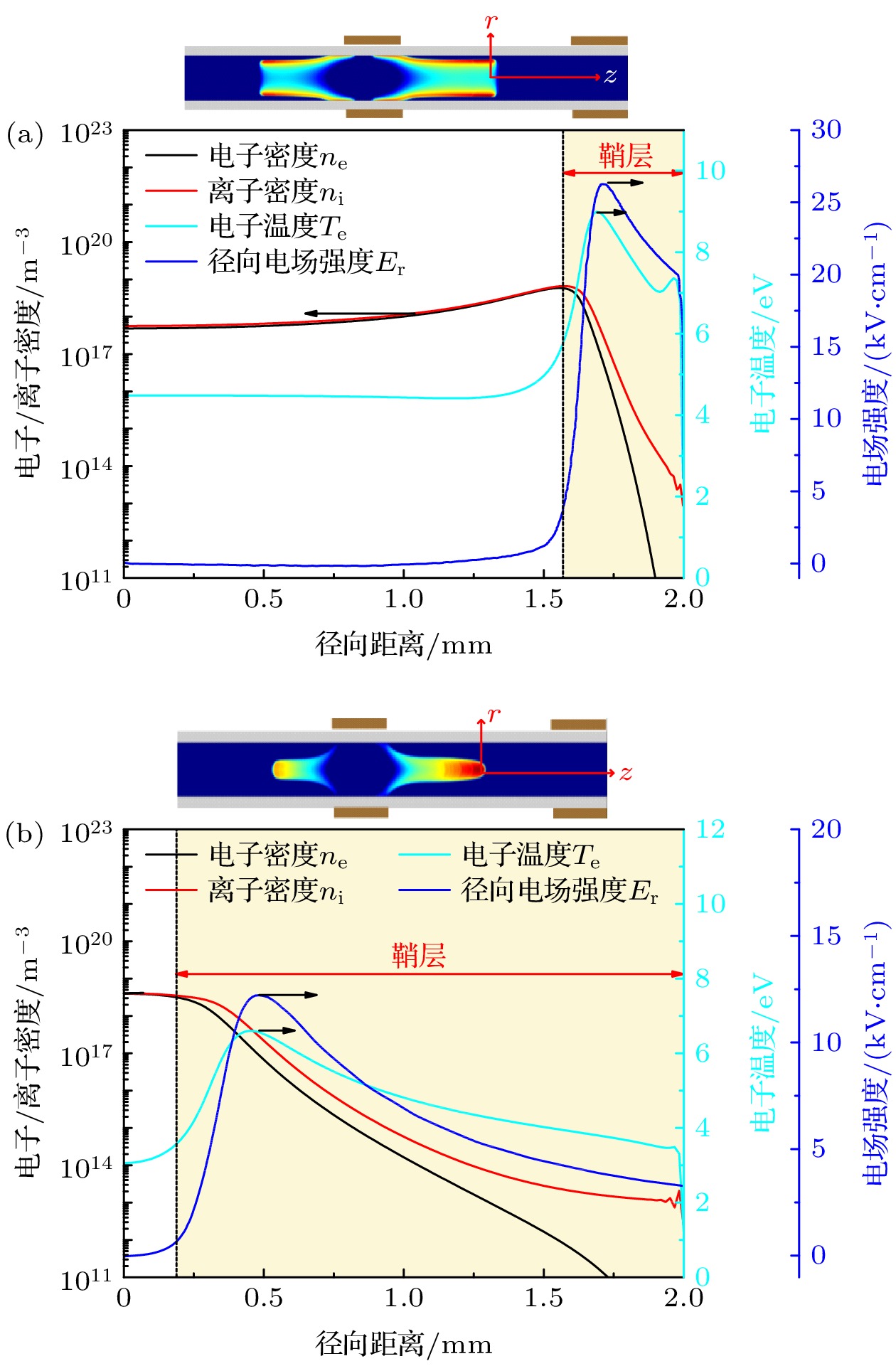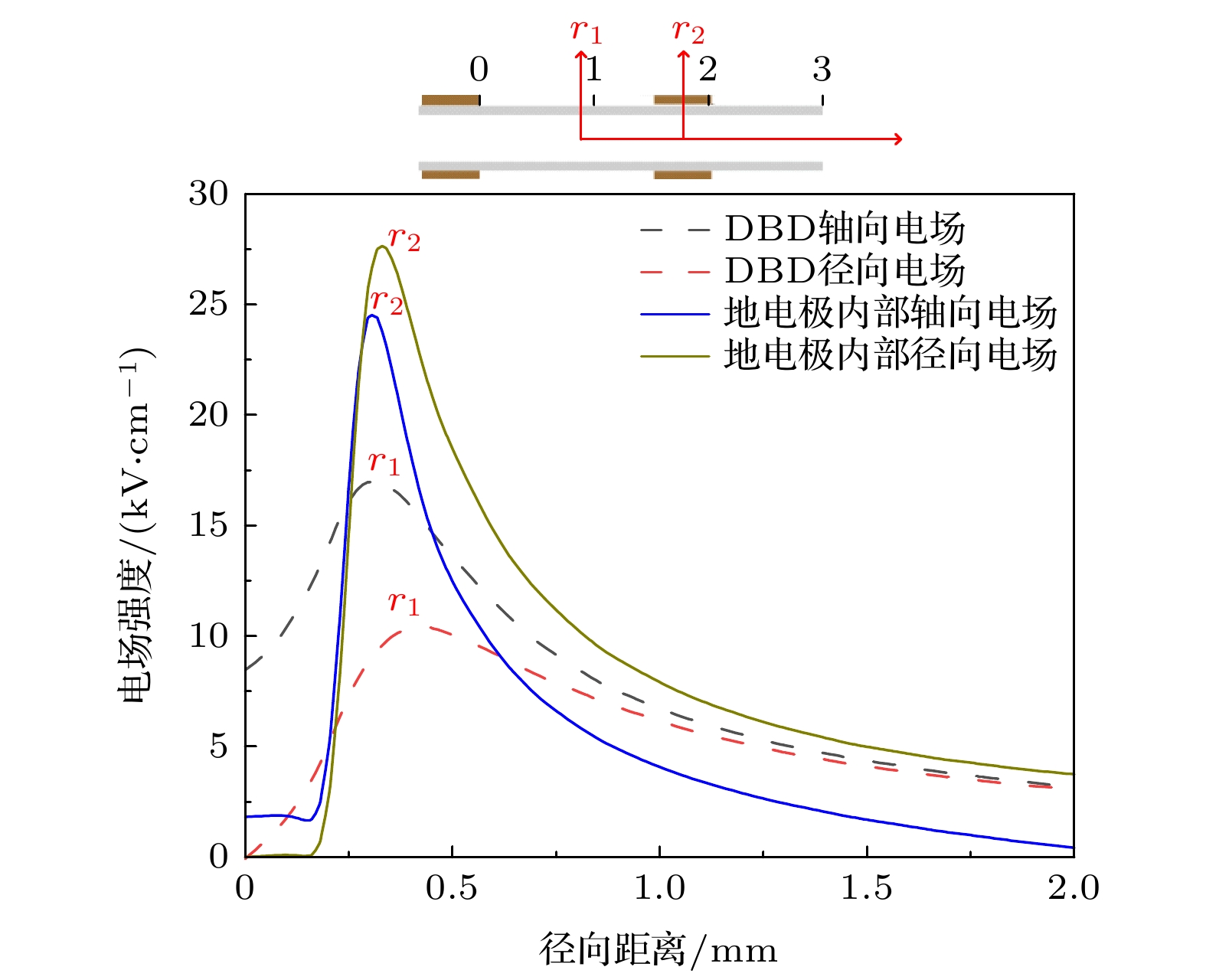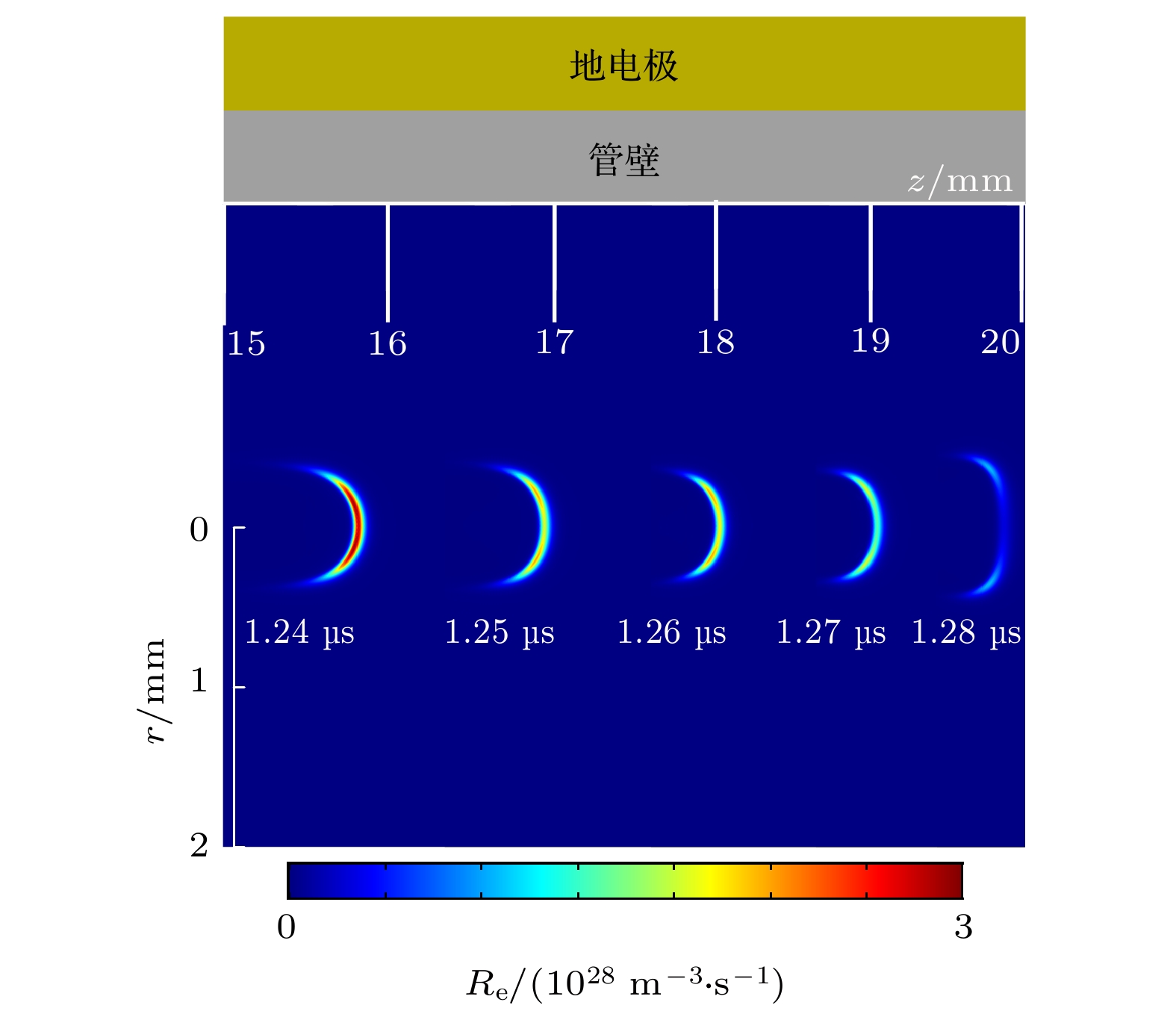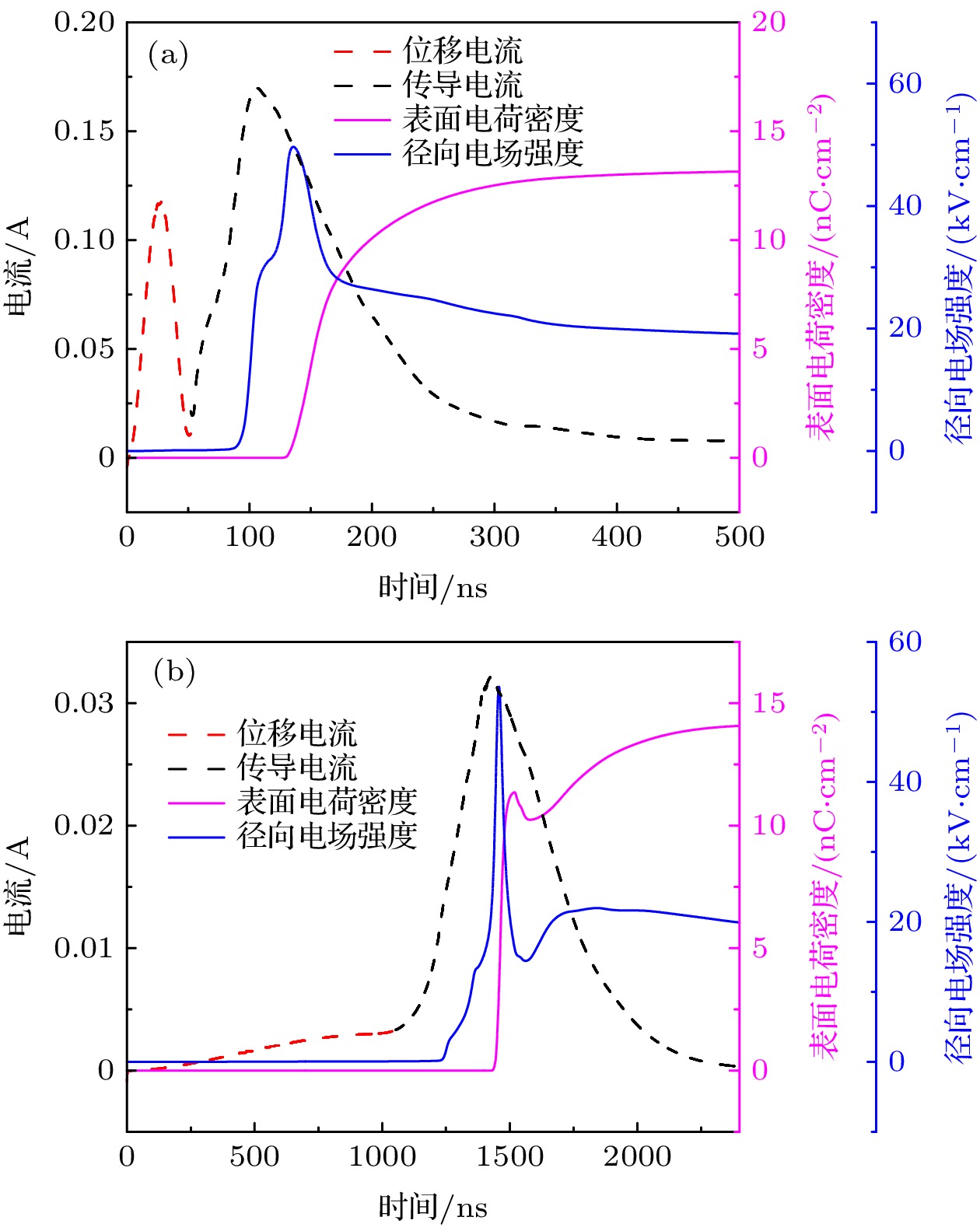-
通过仿真和实验相结合的手段, 以直流脉冲电压驱动的双环电极结构He大气压等离子体射流为例, 研究了电压上升沿时间对管内放电等离子体发展演化特性的影响. 随着电压上升沿的改变, 管内介质阻挡放电(dielectric barrier discharge, DBD)区出现空心和实心两种放电模式. 上升沿为纳秒和亚微秒量级时, 以空心模式发展, 上升沿持续增加后转变为实心模式. 放电模式本质上受鞘层厚度、管内电场和表面电荷密度分布的影响, 鞘层厚度小于1.8 mm时等离子体通常以空心模式传播, 等于1.8 mm时等离子体的径向传播范围有限而转变为实心传播. 管内DBD区, 电场以轴向分量为主时, 等离子体以放电起始时的模式传播; 而在地电极内部, 由于外施电场方向发生径向偏转, 同时管壁沉积的正电荷形成径向自建电场, 两者叠加形成的强径向电场致使放电以空心模式传播.
-
关键词:
- He 大气压等离子体射流 /
- 放电模式 /
- 等离子体鞘层 /
- 上升沿时间
In this work, we employ pulse voltage to drive an atmospheric pressure plasma jet (APPJ) in Helium, and consider mainly the evolution of discharge inside tube. Specifically, the effects of rising edge on the discharge evolution are studied through the simulation and experiment. The spatiotemporal evolution of electron density, ionization source, electron temperature and excited helium atom are evaluated. Besides, the mechanism affecting the rise time is analyzed by the parameters such as discharge current, sheath thickness and surface charge density distribution. In the considered cases, the ionization wave propagates to the ground electrode and downstream of the active electrode in the dielectric tube. The plasma with faster rising edge has larger electron temperature, discharge current, electron density and electric field strength. With the change of voltage rising edge, there occur two discharge modes: hollow mode and solid mode in dielectric barrier discharge (DBD) area. When the rising edge is of nanosecond and sub microsecond, it develops into hollow mode, and changes into solid mode after the rising edge has continued to increase. Both discharge modes are essentially affected by the sheath thickness, the electric field distribution, and the surface charge density inside the tube. When the sheath thickness is less than 1.8 mm, the plasma usually propagates in hollow mode, and when the sheath thickness is equal to 1.8 mm, the radial propagation range of the plasma is limited and changes into solid propagation. In the DBD region, when the electric field is mainly axial component, the plasma propagates in the mode at the beginning of discharge; inside the ground electrode, owing to the fact that the applied electric field is deviated from the radial direction, and that the positive charge deposited on the tube wall forms a radial self-built electric field, the strong radial electric field formed by the superposition of the two fields causes the discharge to propagate in hollow mode.-
Keywords:
- He atmospheric pressure plasma jet /
- discharge mode /
- plasma sheath /
- rising edge
[1] Chang Z S, Li G Q, Liu J R, Xu D H, Shi X M, Zhang G J 2019 Plasma Processes Polym. 16 e1800165 10
[2] Xu G M, Shi X M, Cai J F, Chen S L, Li P, Yao C W, Chang Z S, Zhang G J 2015 Wound Repair Regen. 23 878
 Google Scholar
Google Scholar
[3] Liu K, Ren W, Ran C F, Zhou R S, Tang W B, Zhou R W, Yang Z H, Kostya O 2021 J. Phys. D: Appl. Phys. 54 065201
 Google Scholar
Google Scholar
[4] Chen S L, Wang S, Wang Y B, Guo B H, Li G Q, Chang Z S, Zhang G J 2017 Appl. Surf. Sci. 414 107
 Google Scholar
Google Scholar
[5] Naidis G V 2012 J. Appl. Phys. 112 103304
 Google Scholar
Google Scholar
[6] Zheng Y S, Wang L J, Wang D 2018 J. Appl. Phys. 124 123301
 Google Scholar
Google Scholar
[7] Lu X, Naidis G V, Laroussi M, Reuter S, Graves D B, Ostrikov K 2016 Phys. Rep. 630 1
 Google Scholar
Google Scholar
[8] Zhang C, Shao T, Wang R X, Zhou Z S, Zhou Y X, Yan P 2014 Phys. Plasmas 21 103505
 Google Scholar
Google Scholar
[9] Chang Z S, Yao C W, Chen S L, Zhang G J 2016 Phys. Plasmas 23 093503
 Google Scholar
Google Scholar
[10] Chang Z S, Zhao N, Li G Q, Zhang G J 2018 Sci. Rep. 8 7599
 Google Scholar
Google Scholar
[11] Huang B D, Takashima K, Zhu X M, Pu Y K 2015 J. Phys. D:Appl. Phys. 48 125202
 Google Scholar
Google Scholar
[12] Liu Y D, Tan Z Y, Chen X X, Li X T, Wang X L, Zhang H M, Pan J 2018 IEEE Trans. Plasma Sci. 46 2865
 Google Scholar
Google Scholar
[13] Iza F, Walsh J L, Kong M G 2009 IEEE Trans. Plasma Sci. 37 1289
 Google Scholar
Google Scholar
[14] Ayan H, Staack D, Fridman G, Gutsol A, Mukhin Y, Starikovskii A, Fridman A, Friedman G 2009 J. Phys. D:Appl. Phys. 42 125202
 Google Scholar
Google Scholar
[15] Qian M Y, Li G, Liu S Q, Zhang Y, Li S, Lin Z B, Wang D Z 2017 Plasma Sci. Technol. 19 064015
 Google Scholar
Google Scholar
[16] Zhang Y, Liang X, Li J, Wei L 2018 IEEE Trans. Plasma Sci. 46 103
 Google Scholar
Google Scholar
[17] Wu S, Xu H, Lu X, Pan Y 2013 Plasma Processes Polym. 10 136
 Google Scholar
Google Scholar
[18] Gong W W, Huang Q J, Wang Z, Yang Y 2014 IEEE Trans. Plasma Sci. 42 2868
 Google Scholar
Google Scholar
[19] 赵勇, 王瑞雪, 章程, 郑书河, 邵涛 2019 电工技术学报 34 174
Zhao Y, Wang R X, Zhang C, Zheng S H, Shao T 2019 Tran. China, Electrotechnical Soc. 34 174 (in Chinese)
[20] Chen S L, Chen X Y, Yao C W, Xu G M, Chang Z S, Zhang G J 2018 Phys. Plasmas 25 083510
 Google Scholar
Google Scholar
[21] Li C, Tang X L, Qiu G 2008 Spectrosc. Spectr. Anal. 28 2754
 Google Scholar
Google Scholar
[22] Qian M Y, Ren C S, Wang D Z, Zhang J L, Wei G D 2010 J. Appl. Phys. 107 063303
 Google Scholar
Google Scholar
[23] Li G Q, Chen X, Zhu Y R, Guo H L, Zhao N, Chang Z S 2021 J. Phys. D: Appl. Phys. 54 285204
 Google Scholar
Google Scholar
[24] Hagelaar G J M, Pitchford L C 2005 Plasma Sources Sci. Technol. 14 722
 Google Scholar
Google Scholar
[25] Ning W J, Dai D, Zhang Y H, Han Y X, Li L C 2018 J. Phys. D:Appl. Phys. 51 125204
 Google Scholar
Google Scholar
[26] Zhu P, Li B, Duan Z C, Ouyang J T 2018 J. Phys. D:Appl. Phys. 51 405202
 Google Scholar
Google Scholar
[27] Kettlitz M, Hoft H, Hoder T, Weltmann K D, Brandenburg R 2013 Plasma Sources Sci. Technol. 22 025003
 Google Scholar
Google Scholar
[28] Jiang N, Ji A, Cao Z 2010 J. Appl. Phys. 108 033302
 Google Scholar
Google Scholar
[29] Jansky J, Bourdon A 2011 Appl. Phys. Lett. 99 161504
 Google Scholar
Google Scholar
[30] Ning W J, Dai D, Li L C 2018 Plasma Processes Polym. 15 e1800010
 Google Scholar
Google Scholar
[31] Li J R, Zhang J, Wang Y H, Jiang Y Y, Wang D Z 2021 IEEE Trans. Plasma Sci. 49 234
 Google Scholar
Google Scholar
[32] Babaeva N Y, Naidis G V 2016 IEEE Trans. Plasma Sci. 44 899
 Google Scholar
Google Scholar
[33] Jansky J, Bourdon A 2011 Eur. Phys. J. Appl. Phys. 55 13810
 Google Scholar
Google Scholar
[34] Sato Y, Ishikawa K, Tsutsumi T, Hori M 2020 Appl. Phys. Express 13 086001
 Google Scholar
Google Scholar
-
图 3 实验和仿真中50 ns上升沿时的电压电流波形 (a) 实验总电流波形; (b)剔除位移分量的实验电流波形, 其中序号1—27分别表示ICCD连续拍摄的时间段; (c) 仿真总电流波形
Fig. 3. Discharge voltage and current waveforms with rising edge of 50 ns in experiment and simulation: (a) Experimental full current waveform; (b) experimental current waveform excluding displacement current, the number 1–27 represent the time interval of ICCD continuous acquisition respectively; (c) simulation full current waveform.
图 7 不同上升沿时, DBD区的仿真和实验对比 (a) 50 ns; (b) 200 ns; (c) 500 ns (za, zb和zc分别代表GSD和FWHM提取位置)
Fig. 7. Simulation and experimental results comparison of DBD area under different rising edge: (a) 50 ns; (b) 200 ns; (c) 500 ns. (za, zb and zc represent the data extraction position of GSD and FWHM respectively).
图 8 正脉冲放电期间的电子密度及电离源项分布 (a) z = 0.3, 0.9 cm处的电子密度ne; (b) z = 0.3, 0.9 cm处的电离源项Re; (c) z = 2.0, 2.5 cm处的电子密度ne; (d) z = 2.0, 2.5 cm处的电离源项Re
Fig. 8. Distribution of electron density and ionization source during positive discharge: (a) Electron density when z = 0.3, 0.9 cm; (b) ionization source when z = 0.3, 0.9 cm; (c) electron density when z = 2.0, 2.5 cm; (d) ionization source when z = 2.0, 2.5 cm.
图 9 不同上升沿的外施电压下, 放电头部位于z = 0.9 cm时管内的电子密度、离子密度、电子温度、鞘层厚度及径向电场强度的径向分布 (a) 50 ns; (b) 2000 ns
Fig. 9. Radial distribution of electron density, ion density, electron temperature, sheath, and radial electric field intensity under the applied voltage with different rising edge when the head of plasma at z = 0.9 cm: (a) 50 ns; (b) 2000 ns
图 12 2000 ns上升沿“子弹”头部位于不同位置时, 地电极内部介质管内壁表面电荷密度和径向电场沿轴向的分布 (a) z = 2.3 cm; (b) z = 2.5 cm
Fig. 12. Axial distribution of surface charge density and radial electric field on the inner wall of dielectric tube in the ground electrode when the head of plasma at different positions under rising edge of 2000 ns: (a) z = 2.3 cm; (b) z = 2.5 cm.
表 1 模型中考虑的粒子及反应
Table 1. Plasma chemistry included in the model.
No. 反应式 反应速率或汤森系数 参考文献 R1 e + He → e + He α1 [24] R2 e + He → e + He* α2 [24] R3 e + He → 2e + He+ α3 [24] R4 e + He* → 2e + He+ $ 4.661 \times 10^{-16} T_{\rm e}^{0.6}\cdot {\rm e}^{(-55400/T_{\rm e})} $ [25] R5 2He* → e + He+ + He 4.5 × 10–16 [25] R6 2e + He+ → e + He* 6.186 × 10–39 $ T_{\rm e}^{-4.4} $ [25] R7 2He + He+ → He + ${\rm{He}}_2^+ $ 1 × 10–43 [25] R8 2e + ${\rm{He}}_2^+ $ → e + He + He* 2.8 × 10–32 [25] R9 e + He + He+ → He + He* 6.66 × 10–42 $ T_{\rm e}^{-2} $ [25] R10 e + He + ${\rm{He}}_2^+ $ → 2He + He* 3.5 × 10–39 [26] R11 2He* → e + ${\rm{He}}_2^+ $ 2.3 × 10–15 [26] R12 e + ${\rm{He}}_2^+ $ → He + He* 5.386 × 10–13 $ T_{\rm e}^{-0.5} $ [25] 注: Te 为电子温度(eV); α1, α2, α3 通过玻尔兹曼求解器求解[24] , 双体和三体反应的单位分别为m3·s–1和m6·s–1. 表 2 实验电流峰值时刻不同上升沿在管内za, zb, zc位置处的灰度值标准差和相对强度半高宽及仿真中电流峰值时刻对应位置处的相对强度半高宽统计
Table 2. GSD and the relative intensity FWHM at za, zb, zc of APPJ driven by different rising time at the time of current peak in experiment and the FWHM at the corresponding position at the time of current peak in simulation.
位置 50 ns 200 ns 500 ns 实验光强灰度值标准差 za 28.6 33.3 49.6 zb 35.3 37.7 50.4 zc 31.0 30.0 46.9 实验相对强度半高宽/mm za 2.92 2.76 2.55 zb 2.48 2.31 1.98 zc 2.91 2.38 1.83 仿真He*分布半高宽/mm za 3.36 3.12 2.76 zb 3.28 3.16 2.88 zc 3.44 3.30 2.72 -
[1] Chang Z S, Li G Q, Liu J R, Xu D H, Shi X M, Zhang G J 2019 Plasma Processes Polym. 16 e1800165 10
[2] Xu G M, Shi X M, Cai J F, Chen S L, Li P, Yao C W, Chang Z S, Zhang G J 2015 Wound Repair Regen. 23 878
 Google Scholar
Google Scholar
[3] Liu K, Ren W, Ran C F, Zhou R S, Tang W B, Zhou R W, Yang Z H, Kostya O 2021 J. Phys. D: Appl. Phys. 54 065201
 Google Scholar
Google Scholar
[4] Chen S L, Wang S, Wang Y B, Guo B H, Li G Q, Chang Z S, Zhang G J 2017 Appl. Surf. Sci. 414 107
 Google Scholar
Google Scholar
[5] Naidis G V 2012 J. Appl. Phys. 112 103304
 Google Scholar
Google Scholar
[6] Zheng Y S, Wang L J, Wang D 2018 J. Appl. Phys. 124 123301
 Google Scholar
Google Scholar
[7] Lu X, Naidis G V, Laroussi M, Reuter S, Graves D B, Ostrikov K 2016 Phys. Rep. 630 1
 Google Scholar
Google Scholar
[8] Zhang C, Shao T, Wang R X, Zhou Z S, Zhou Y X, Yan P 2014 Phys. Plasmas 21 103505
 Google Scholar
Google Scholar
[9] Chang Z S, Yao C W, Chen S L, Zhang G J 2016 Phys. Plasmas 23 093503
 Google Scholar
Google Scholar
[10] Chang Z S, Zhao N, Li G Q, Zhang G J 2018 Sci. Rep. 8 7599
 Google Scholar
Google Scholar
[11] Huang B D, Takashima K, Zhu X M, Pu Y K 2015 J. Phys. D:Appl. Phys. 48 125202
 Google Scholar
Google Scholar
[12] Liu Y D, Tan Z Y, Chen X X, Li X T, Wang X L, Zhang H M, Pan J 2018 IEEE Trans. Plasma Sci. 46 2865
 Google Scholar
Google Scholar
[13] Iza F, Walsh J L, Kong M G 2009 IEEE Trans. Plasma Sci. 37 1289
 Google Scholar
Google Scholar
[14] Ayan H, Staack D, Fridman G, Gutsol A, Mukhin Y, Starikovskii A, Fridman A, Friedman G 2009 J. Phys. D:Appl. Phys. 42 125202
 Google Scholar
Google Scholar
[15] Qian M Y, Li G, Liu S Q, Zhang Y, Li S, Lin Z B, Wang D Z 2017 Plasma Sci. Technol. 19 064015
 Google Scholar
Google Scholar
[16] Zhang Y, Liang X, Li J, Wei L 2018 IEEE Trans. Plasma Sci. 46 103
 Google Scholar
Google Scholar
[17] Wu S, Xu H, Lu X, Pan Y 2013 Plasma Processes Polym. 10 136
 Google Scholar
Google Scholar
[18] Gong W W, Huang Q J, Wang Z, Yang Y 2014 IEEE Trans. Plasma Sci. 42 2868
 Google Scholar
Google Scholar
[19] 赵勇, 王瑞雪, 章程, 郑书河, 邵涛 2019 电工技术学报 34 174
Zhao Y, Wang R X, Zhang C, Zheng S H, Shao T 2019 Tran. China, Electrotechnical Soc. 34 174 (in Chinese)
[20] Chen S L, Chen X Y, Yao C W, Xu G M, Chang Z S, Zhang G J 2018 Phys. Plasmas 25 083510
 Google Scholar
Google Scholar
[21] Li C, Tang X L, Qiu G 2008 Spectrosc. Spectr. Anal. 28 2754
 Google Scholar
Google Scholar
[22] Qian M Y, Ren C S, Wang D Z, Zhang J L, Wei G D 2010 J. Appl. Phys. 107 063303
 Google Scholar
Google Scholar
[23] Li G Q, Chen X, Zhu Y R, Guo H L, Zhao N, Chang Z S 2021 J. Phys. D: Appl. Phys. 54 285204
 Google Scholar
Google Scholar
[24] Hagelaar G J M, Pitchford L C 2005 Plasma Sources Sci. Technol. 14 722
 Google Scholar
Google Scholar
[25] Ning W J, Dai D, Zhang Y H, Han Y X, Li L C 2018 J. Phys. D:Appl. Phys. 51 125204
 Google Scholar
Google Scholar
[26] Zhu P, Li B, Duan Z C, Ouyang J T 2018 J. Phys. D:Appl. Phys. 51 405202
 Google Scholar
Google Scholar
[27] Kettlitz M, Hoft H, Hoder T, Weltmann K D, Brandenburg R 2013 Plasma Sources Sci. Technol. 22 025003
 Google Scholar
Google Scholar
[28] Jiang N, Ji A, Cao Z 2010 J. Appl. Phys. 108 033302
 Google Scholar
Google Scholar
[29] Jansky J, Bourdon A 2011 Appl. Phys. Lett. 99 161504
 Google Scholar
Google Scholar
[30] Ning W J, Dai D, Li L C 2018 Plasma Processes Polym. 15 e1800010
 Google Scholar
Google Scholar
[31] Li J R, Zhang J, Wang Y H, Jiang Y Y, Wang D Z 2021 IEEE Trans. Plasma Sci. 49 234
 Google Scholar
Google Scholar
[32] Babaeva N Y, Naidis G V 2016 IEEE Trans. Plasma Sci. 44 899
 Google Scholar
Google Scholar
[33] Jansky J, Bourdon A 2011 Eur. Phys. J. Appl. Phys. 55 13810
 Google Scholar
Google Scholar
[34] Sato Y, Ishikawa K, Tsutsumi T, Hori M 2020 Appl. Phys. Express 13 086001
 Google Scholar
Google Scholar
计量
- 文章访问数: 7957
- PDF下载量: 132
- 被引次数: 0













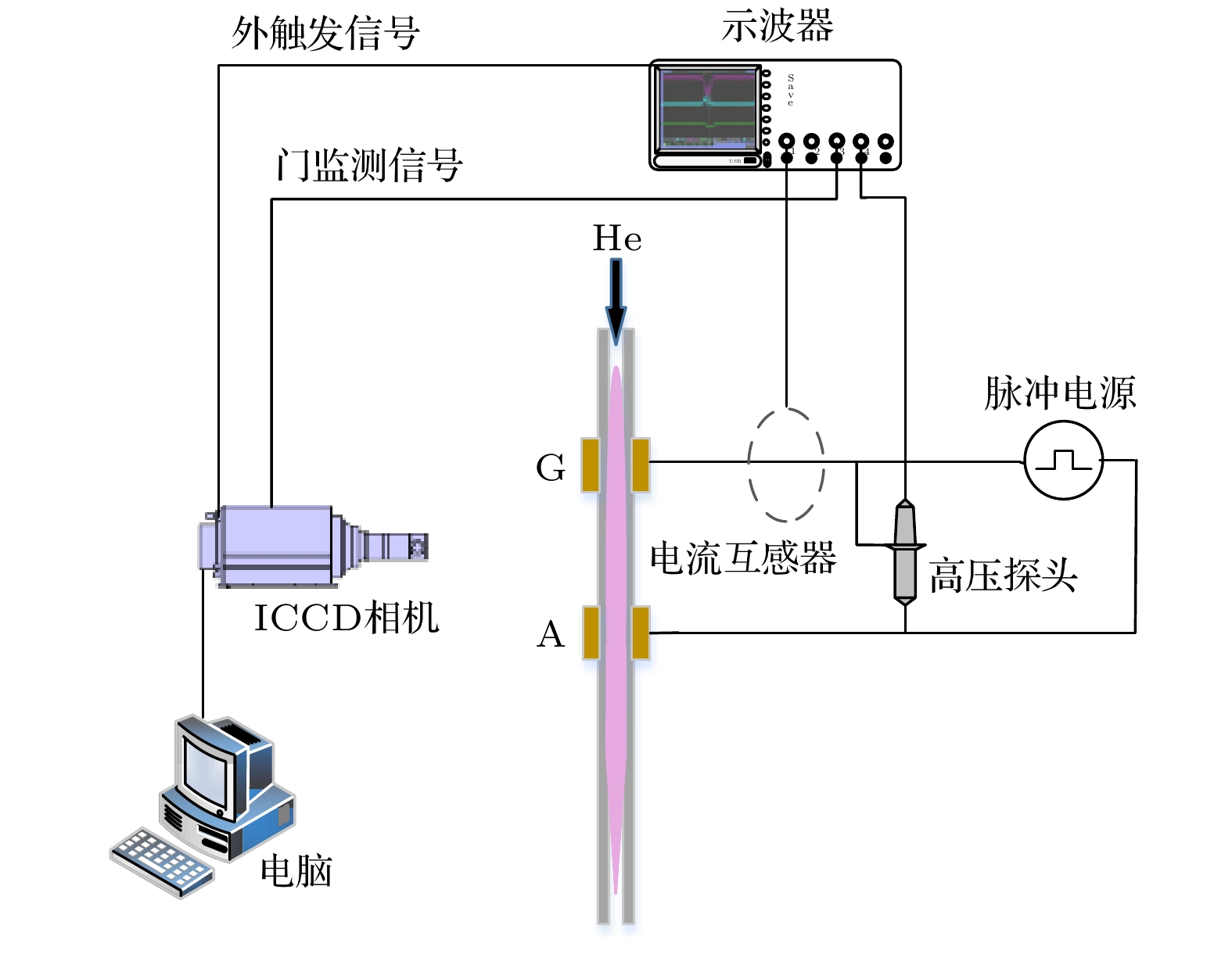
 下载:
下载:


